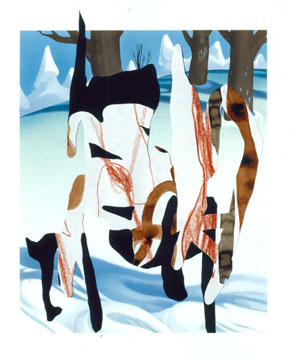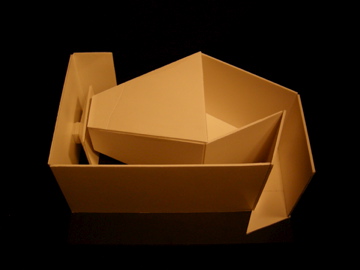The Aldrich Contemporary Art Museum
Docent Notes
1.8.2007
Jessica Hough
Bill Schott
Arturo Herrera, Dario Robleto & David Abir
Beginning March 11, 2007 at The Aldrich Museum
Photograph as Canvas (curated by Stephen Maine)
David Abir: Tekrar
Elana Herzog & Michael Schumacher: W(E)AVE
Kysa Johnson: Blow Ups—Spores, Pollen, and Pollutants
Arturo Herrera: Castles, Dwarfs, and Happychaps
Dario Robleto: Chrysanthemum Anthems
Arturo Herrera: Castles, Dwarfs, and Happychaps

Jessica began her presentation with works from Arturo Herrera’s exhibition.
JH: A key theme that exists in both Herrera’s and Robleto’s work is the idea of collage. Can you name artists that successfully employ collage?
Docents: Schwitters, Cornell, Picasso, Rauschenberg
JH: What comes to mind when you think of collage?
Docents: Shock, combining readymades, odd juxtapositions, Surrealists, and the Exquisite Corpse.
JH: Photomontage is economically inexpensive (time and materials).
Arturo was born in Venezuela in 1959. He currently lives in Berlin, and exhibits at the Sikkema Jenkins gallery in NYC. (http://sikkemajenkinsco.com/). For this exhibition we will be showing a site-specific mural in the Leir Gallery with pounced dry pigment, silkscreen prints, and potentially a work to cover the edifice of Old Hundred, The Aldrich Museum’s administration building facing Main Street. In Ingrid Schaffner’s highly recommended text, “Recortes El arte de Arturo Herrera,” Arturo Hererra (Centro Galego De Arte Contemporanea: 2005), she discusses the struggle to engage the real world with modern painting, and collage as a visual language. For this exhibition there will be two sets of thirteen prints on display. All in all, there will be twenty-six of the series of sixty-five original silkscreens to view. The series was inspired by Disney cartoons and the backgrounds on each were commissioned, giving Arturo a surface to improvise upon. This process allows Arturo to utilize chance in his work. He is comfortable with giving that control to his assistants. On top, Arturo’s hand implements different materials—paint, pencil and mixed mediums. Overall, there is “nostalgia” in this collage. This nostalgia is very important because it develops a relationship with the viewer. It is a conceptual collage as well as a physical collage assembling individual memories.

In addition to these works, Arturo plans to display a large scrim on top of the edifice of The Aldrich’s administration building. This exterior faces Main Street and will be easily viewable from the road. The proposed concept incorporates spliced segments of lines from familiar characters overlaid by layered abstraction. It is a visual experience.
Dario Robleto: Chrysanthemum Anthems

Jessica discussed another exhibition opening this March, with work by Dario Robleto. Dario is 34 and lives in San Antonio, Texas. He also uses collage as a medium of choice, but Dario’s work ends up taking a much different form. A central element to his work is the description of the materials implemented. For example: in one work, A soul waits for a story survives, he uses bone dust, fragments of uniforms, and shrapnel from the Civil and Revolutionary wars. (Robleto’s interest in the Revolutionary War makes Ridgefield, with its Revolutionary War battle locations, a very appropriate venue in which to view his work.) The works comment on the way wars have impacted people with pain and suffering. Again, in Ingrid Schaffner’s text, she discusses how collage “splices bits of the real world into pictorial space.” This mixing and sampling of material is akin to making music. Considering music is imperative to understanding the work.
The process of collecting materials and then taking the pulp of a Civil War-era letter, or smelting the lead from a medal, gets to a very raw essence within art-making. Therefore the title and list of materials is integral to considering the work. For instance, in one piece there is a bullet with teeth marks in it. During the revolutionary and civil wars, it was a customary medical procedure to amputate a limb. Often, bits for the patient to bite down upon were rare, so instead, a bullet would be used. This is how the term “biting the bullet” came about. This style of art-making is akin to the precursor to modern chemistry, alchemy. Through the transmutation of material matter, Dario believes that the essence of the maker/moment is transformed into the new form. It retains the essence even though it takes a different shape. He views it as a meditation on healing and that the pain is still conveyed. In addition, he archives the original by taking a digital photograph before altering any object. However, he will not alter any item that has overt historical significance.
Some docents asked if he was working with any artifacts/ relics from the Iraq war. Not to anyone’s knowledge.
Jessica continued by saying that other works, known as reliquaries—bones or hair from a deceased person—are artworks of relevance. In addition, there is another branch of artwork, known as Trench Art. Trench Art is a broader range of work crafted during times of war, with war materials, or by soldiers in action, or off the battlefield when wounded. For more information, please see a recent exhibition at D’Amelio Terras-, entitled Fear and Tenderness in Men.
David Abir: Tekrar

Lastly, Jessica Hough discussed the sound installation by David Abir. This installation will be on view in the Sound Gallery and will model an enlarged version of the interior anatomy of a human ear. David Abir is an Iranian American who has crafted sound accompaniments to exhibitions by Shahzia Sikander and Sherin Neshat. This installation is his first solo exhibition. There is much excitement. He is crafting a moody soundtrack along with a physical structure that is an immersive space with synchronous lighting. As the music shifts, so will the lighting of the project space. Tekrar, the Farsi word for repetition, refers back to the musical structures implemented in this work.
Docent Notes
1.8.2007
Jessica Hough
Bill Schott
Arturo Herrera, Dario Robleto & David Abir
Beginning March 11, 2007 at The Aldrich Museum
Photograph as Canvas (curated by Stephen Maine)
David Abir: Tekrar
Elana Herzog & Michael Schumacher: W(E)AVE
Kysa Johnson: Blow Ups—Spores, Pollen, and Pollutants
Arturo Herrera: Castles, Dwarfs, and Happychaps
Dario Robleto: Chrysanthemum Anthems
Arturo Herrera: Castles, Dwarfs, and Happychaps

Jessica began her presentation with works from Arturo Herrera’s exhibition.
JH: A key theme that exists in both Herrera’s and Robleto’s work is the idea of collage. Can you name artists that successfully employ collage?
Docents: Schwitters, Cornell, Picasso, Rauschenberg
JH: What comes to mind when you think of collage?
Docents: Shock, combining readymades, odd juxtapositions, Surrealists, and the Exquisite Corpse.
JH: Photomontage is economically inexpensive (time and materials).
Arturo was born in Venezuela in 1959. He currently lives in Berlin, and exhibits at the Sikkema Jenkins gallery in NYC. (http://sikkemajenkinsco.com/). For this exhibition we will be showing a site-specific mural in the Leir Gallery with pounced dry pigment, silkscreen prints, and potentially a work to cover the edifice of Old Hundred, The Aldrich Museum’s administration building facing Main Street. In Ingrid Schaffner’s highly recommended text, “Recortes El arte de Arturo Herrera,” Arturo Hererra (Centro Galego De Arte Contemporanea: 2005), she discusses the struggle to engage the real world with modern painting, and collage as a visual language. For this exhibition there will be two sets of thirteen prints on display. All in all, there will be twenty-six of the series of sixty-five original silkscreens to view. The series was inspired by Disney cartoons and the backgrounds on each were commissioned, giving Arturo a surface to improvise upon. This process allows Arturo to utilize chance in his work. He is comfortable with giving that control to his assistants. On top, Arturo’s hand implements different materials—paint, pencil and mixed mediums. Overall, there is “nostalgia” in this collage. This nostalgia is very important because it develops a relationship with the viewer. It is a conceptual collage as well as a physical collage assembling individual memories.

In addition to these works, Arturo plans to display a large scrim on top of the edifice of The Aldrich’s administration building. This exterior faces Main Street and will be easily viewable from the road. The proposed concept incorporates spliced segments of lines from familiar characters overlaid by layered abstraction. It is a visual experience.
Dario Robleto: Chrysanthemum Anthems

Jessica discussed another exhibition opening this March, with work by Dario Robleto. Dario is 34 and lives in San Antonio, Texas. He also uses collage as a medium of choice, but Dario’s work ends up taking a much different form. A central element to his work is the description of the materials implemented. For example: in one work, A soul waits for a story survives, he uses bone dust, fragments of uniforms, and shrapnel from the Civil and Revolutionary wars. (Robleto’s interest in the Revolutionary War makes Ridgefield, with its Revolutionary War battle locations, a very appropriate venue in which to view his work.) The works comment on the way wars have impacted people with pain and suffering. Again, in Ingrid Schaffner’s text, she discusses how collage “splices bits of the real world into pictorial space.” This mixing and sampling of material is akin to making music. Considering music is imperative to understanding the work.
The process of collecting materials and then taking the pulp of a Civil War-era letter, or smelting the lead from a medal, gets to a very raw essence within art-making. Therefore the title and list of materials is integral to considering the work. For instance, in one piece there is a bullet with teeth marks in it. During the revolutionary and civil wars, it was a customary medical procedure to amputate a limb. Often, bits for the patient to bite down upon were rare, so instead, a bullet would be used. This is how the term “biting the bullet” came about. This style of art-making is akin to the precursor to modern chemistry, alchemy. Through the transmutation of material matter, Dario believes that the essence of the maker/moment is transformed into the new form. It retains the essence even though it takes a different shape. He views it as a meditation on healing and that the pain is still conveyed. In addition, he archives the original by taking a digital photograph before altering any object. However, he will not alter any item that has overt historical significance.
Some docents asked if he was working with any artifacts/ relics from the Iraq war. Not to anyone’s knowledge.
Jessica continued by saying that other works, known as reliquaries—bones or hair from a deceased person—are artworks of relevance. In addition, there is another branch of artwork, known as Trench Art. Trench Art is a broader range of work crafted during times of war, with war materials, or by soldiers in action, or off the battlefield when wounded. For more information, please see a recent exhibition at D’Amelio Terras-, entitled Fear and Tenderness in Men.
David Abir: Tekrar

Lastly, Jessica Hough discussed the sound installation by David Abir. This installation will be on view in the Sound Gallery and will model an enlarged version of the interior anatomy of a human ear. David Abir is an Iranian American who has crafted sound accompaniments to exhibitions by Shahzia Sikander and Sherin Neshat. This installation is his first solo exhibition. There is much excitement. He is crafting a moody soundtrack along with a physical structure that is an immersive space with synchronous lighting. As the music shifts, so will the lighting of the project space. Tekrar, the Farsi word for repetition, refers back to the musical structures implemented in this work.


0 Comments:
Post a Comment
Subscribe to Post Comments [Atom]
<< Home